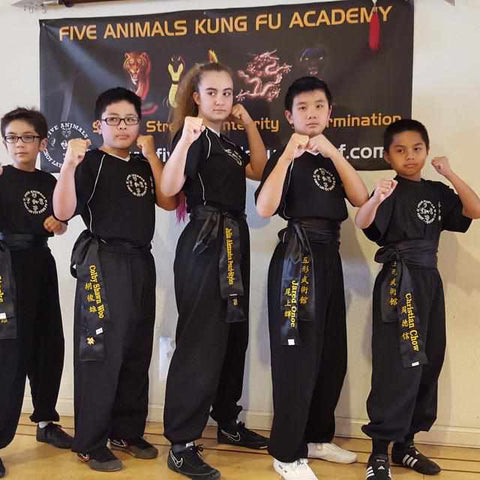This article is part of our series on the subject of "Fake Martial Arts". Read more:
- Why Fake Martial Arts Exist (And Why They Always Will?)
- Top 5 Lies Fake Martial Artists Keep Telling Everyone (And What They Really Mean)
- Top 15 Signs Your Martial Arts Teacher Is Fake
- What Is A Kung Fu LARPer?
- Jet Li on Fake Masters & What Is Real Kung Fu
What Is A McDojo?
The definition of a "McDojo" is a martial arts school that is solely established to make money instead of genuinely teaching martial arts.

Due to the widespread popularity (watering down) and commercialization of the martial arts in the last half century, a huge percentage of McDojos have popped up in the United States, North America, and around the world.
While McDojos exist everywhere (as well as in their countries of origin), the chances of these McDojos popping up and staying for a long time in their native countries of origin are less common, as it is more difficult to be "fake" in a country where the martial art originated from, as there would be much more competition and scrutiny both from a sports performance aspect as well as pressure from a cultural / societal aspect (although there are exceptions).
For example, if you opened a pastel de nata bakery in Portugal, it better be amazing. But if you were the only pastel de nata bakery in Alaska, you wouldn't have any competition to be compared to.
But let's focus on the topic at hand: Are you concerned that you or your child may be stepping into a McDojo to learn martial arts?
Read on to find out the top signs of a McDojo, and if your school has checked off the majority of these boxes, your school might very well be a McDojo!
1. Weird Name
The school has a wacky, gimmicky, or vague name that was likely made up, or it references a martial art but isn't actually a martial art that exists.
Can you tell which word / words don't belong?
For example: Joe's Garage Fighting Systems, Snake Crane Boxing, American Jiu-Jitsu, Irish Karate Fu, British Barjitsu Wing Chun, Korean Kenpo Taekwondo, Capoeira Jiu-Jitsu, etc.
2. No Young Adults (Age 15-35)

Wait, what? There's literally a toddler on the left and right hand sides that have black belts. That's not a good sign.
A McDojo is usually a "safe", harmless training environment that tries to cater to the lowest level of student or customer by offering very easy (and unrealistic) training.
If classes are mostly comprised of kids and teens, or older aged out-of-shape mom / dads / granddads / grandmothers, this can be a red flag.
If no young adults or adults train at the school in a serious manner, it may be because able-bodied adults would rather train at a higher level school that actually proposes a realistic challenge.
A low-level training environment is okay for beginners, but that is why classes are split up between beginners, intermediate, to advanced.
If the school offers nothing to the intermediate or advanced levels, this type of training environment likely won't benefit you much longer.
3. "Black Belt" Fast Track Program
If the school offers a "black belt program", where you pay one fee and you will be fast tracked to the rank of black belt in a few years or less, then this is a sure sign that this school exists to make money (as a first priority) and teach martial arts only as a backseat priority.
4. Overused "Black Belt" references

Everyone can be a black belt in our dojo! If you pay enough, you may even get to hold the special rank of red belt!
In the school, either in its name, or the environment, there exists an overuse of the words "black belt". On the walls, there are motivational messages that everyone is capable of reaching "black belt" status, you will become a "guaranteed black belt" at our school, etc.
Trying to cater to the clueless casual customer that anyone can become a "black belt" is one of the biggest signs of a McDojo.
The reality simply isn't true. Becoming a black belt in any martial art takes time, dedication, and serious effort and commitment. Not everyone will achieve black belt status, and even fewer will continue to train after they've obtained their black belt.
5. There Are Fees / Costs To Literally Everything

Belt Stripe #230, After School Pick-Up, Tutoring / Homework Class, Summer Camp, Winter Camp, Valentine's Day Camp, Christmas Camp...
Look, we get it. If you run a school, you have to make money as a business. You have to come up with ideas for extra classes and summer camps for kids and whatnot to pay the bills. As long as the martial arts programs are of quality, then this can be forgiven.
However, it starts to get tacky when everything is slapped with a price tag on it.
While most schools charge fees for belt gradings / testings and private lessons, if they are commercializing every single thing in a martial arts school as an extra fee, this could be a red flag.
A McDojo might charge extra fees for purchasing equipment that only the school sells, in order to participate in a special members-only class.
Or they might be keeping beginners in a beginner's only class, and only if you pay more, do you get "access" to the regular class or sparring class, or open mats.
We can understand if there's a skill gap difference and keeping students injury free, but if this is done deliberately to make beginner students stay at a beginner's level for a set period of time rather than basing it off of their individual skill level, this is a red flag.
If you must pay a belt grading fee and there is a disproportionately large number of stripes of belts that you must pay for, this is also a red flag.
6. No Applications / Sparring

Sparring is the most simple, direct way of testing your martial arts effectiveness in a live but safe and controlled environment.
If applications of martial arts techniques or moves are never taught or shown, only talked about or theorized through compliant demonstrations - this is a red flag.
A McDojo is a place where most classes consist of just technique, drills, and / or forms practice - and no live sparring ever happens.
Sparring is never allowed or there is no sparring component built into the classes.
This is a red flag for good reason.
This class structure ensures that every student stays as clueless as possible about real, effective applications of moves, and the instructor can (potentially) continue to swindle these students without ever needing to prove that they can actually make their moves and techniques work in a real, live, environment.
But what if it's a self-defense martial art? Read more about our thoughts on self-defense martial arts here.
7. Instructor Never Spars

Unless your martial arts coach is injured or a senior citizen, he / she should be able to show you how techniques work in live scenarios, and not just hide behind demonstrations.
The instructor / coach / master / Sifu / Sensei / Sabumnim never engages in free sparring with his students.
While there are exceptions such as accumulation of injuries or advanced age (40+), an instructor should still be able to light spar or light roll with their students.
If the instructor insists that they cannot be touched or cannot spar, or if / when challenged, deflects it to one of their students to accept the challenge, then this is a red flag.
8. No Competitions Allowed or Participation Trophies

If the school never competes in competitions or allows students to compete, this is a red flag.
A McDojo or fake martial arts school will always stay away from competitions because they know they would likely lose every single one of them.
Or conversely - they might compete in every single tournament possible and every single student receives a participation trophy no matter their performance, so that they can scatter it all around the school as a sign that their school only produces "winners".
In martial arts, just as in reality, there is no such thing as a participation trophy. You either win the fight / self defense encounter and escape with your life intact, or you lose and get seriously hurt or even killed.
9. Certifications / Lineage Cannot Be Verified

This is a tricky one, but it mostly rings true.
If your instructor is asked where he / she got their black belt from, or what teacher they studied under, under which lineage or organization, they should have a clear answer, and a quality answer.
This factor is obviously more important for traditional martial arts styles, where importance is placed on authenticity, tradition, terminology, culture, and history (although arguments can be made here that authenticity and traditions are subjective and useless in the real world - but that is a different topic altogether).
For more modern martial arts styles such as combat sports or Mixed Martial Arts (MMA), then the lineage or certification / belt rank is less important, and more importance is placed on sports / competition performance (fight record / experience) and how many champion students a coach has produced.
If a martial arts coach has verifiable in-ring combat experience, titles, or championships, and / or has produced championship students, then their rank or lineage is not as important as they have already proven their experience in the real world.
There is a flip-side to the lineage argument, of course.
If your instructor can ONLY rely on name-dropping and / or throwing around his / her lineage as a means of respect or "authenticity" or "symbol of quality", but has shown no real world skills of his / her own, then watch out, this ones a fake one!
10. Everyone Is Eventually Promoted (Participation Belts)

If your school promotes every student on a timely basis, regardless if they did well on their belt grading or how skilled they actually are, then they are likely a McDojo.
If students get promoted quickly by the school to the next belt or stripe in a matter of months, without actually competing or sparring regularly, then they've essentially earned a higher rank just by participating and showing up to class, rather than show / prove their knowledge and skill level (worse yet, they earned their belt or certification virtually, ie. online).
We all know martial arts is a physical activity, and you cannot trade real training and hard sparring with theoretical knowledge and drilling practice.
Anyone who believes martial arts can be practiced and mastered without real live resistance or fighting is in for a rude, ugly awakening should they find themselves in a dangerous scenario.
A belt rank (or equivalent title of recognition) should be earned through blood, sweat, and years (possibly tears), not just given away by paying money for it or just by "showing up" to class.
11. School Is Top Heavy (Everyone Is A Black Belt)

If almost every student is a black belt (or worse, if in the kids / teen department), then this school is likely a McDojo.
While it may make sense to have a team of high level black belts that compete in a large established gym, it is impossible for any real, quality gym / school to have more experts than there are students (unless it was a professional fighter's gym).
It is because for advanced students, they usually will have gotten as much as they could out of that martial art and either quit / moved on, leave to train at another school, or end up teaching classes or opening their own academy.
Thus, a successful school requires constantly fresh new students to join the gym. Therefore, it is only natural (and normal) that the majority of students are beginners or intermediate level students.
It is rare for a large number of advanced students to stay and continue training at the same place for extended periods of time, for they would most likely be the teachers or instructors already.
If almost every member of the school is advanced, or if there is a large team of instructors who are all black belts, then there might be something fishy going on.
This usually means that their ranks / belts are inflated, and that not all of them could possibly be real black belts.
12. There Are Made Up Ranks / Belts

If the school advertises a certain martial art that traditionally (or at least officially recognized) does not have rankings or belt levels, then watch out, they may be a McDojo.
In arts such as Kung Fu, Muay Thai, or Boxing - there does not exist any known rankings, coloured shorts, sashes, or belts.
Belt levels are largely a modern, commercialized aspect of martial arts schools or coaches looking to establish some sort of a system of progression to encourage students to keep training and to not quit (which is okay).
If the rank within the system can clearly define what a practitioner is supposed to know, and the rank is enforced through quality testing, then it may be okay for it to be employed.
However, if the rank is nothing but a phoney or fictitious way of differentiating between low and high, or ranking students who have paid more / stayed more loyal to the school rather than by actual knowledge or skill, then the rank or belt system is useless and fake.
Especially if the made up ranking system has 10 levels or more - that is a sure sign of making a student pay their way to get to the top.
Can you imagine saying you are a "Level 25" practitioner of this style? If it sounds ridiculous - it probably is!
Beware of instructors who have "black belts" in Kung Fu or Muay Thai - they do not exist!
Conclusion
Do you agree with our list? Let us know in the comments if you think we missed any!
- Dynasty Team


Comments
It’s 5 animals school shown in this picture is definitely not a macdojo
The article is partially true, but not competing in competition, does not mean it’s a Mc Dojo, competition is sport karate, not all dojos practice as a sport. Okinawa. Karate is more aligned with self defense. Okinawa has officially 10 Kyu ranks, that does not mean it’s a MC Dojo. Sometimes dojos sell weapons for students to buy because of the questionable quality outside their dojo, nothing wrong with that.
The article is not very thorough in regards what is real and what is Mc Dojos.
If you want to make a living from the martial arts you do need to be creative, just not rip people off.
An all children’s class does not make it a Mc Dojo, or all older citizens.
Those article has a lot to be desired as to what is Good or bad.
In Okinawa black belts are awarded to Children they are designated as Shodan Ho, and are retested when they reach adulthood.
So get your facts straight.
The Pink belt actually has a great explanation.
Jesse “The Karate Nerd” Enkamp has everyone wear them at his seminars to create a more collaborative/relaxed/ego-free atmosphere. Everywhere wear them from senior instructors to beginners, a great idea.